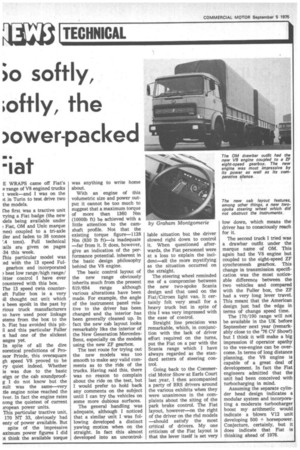io softly, ;oftly, the )ower-packed =iat
Page 22

If you've noticed an error in this article please click here to report it so we can fix it.
E WRAPS came off Fiat's v range of V8 engined trucks t week—and I was on the a in Turin to test drive two the models.
rhe first was a tractive unit Tying a Fiat badge (the new dels being available under Fiat, OM and Unic marque nes) coupled to a tri-axle her and laden to 38 tonnes '.4 tons). Full technical tails are given on pages .34 this week.
rhis particular model was ,ed with the 13 speed Fulgearbox and incorporated best low range/high range/ litter control I have ever countered with this box. The 13 speed twin counteraft Fuller box is a very il thought out unit which s been spoilt in the past by rious truck manufacturers io have used poor linkage stems from the box to the b. Fiat has avoided this pit and this particular Fuller x had one of the slickest anges yet.
In spite of all the dire eoretical predictions of Pro;sor Priede, this oversquare gh speed V8 proved to be ry quiet indeed. Whether is was due to the basic sign or the cab soundproofg I do not know but the suit was the same—very tie engine noise reached the Wei*. In fact the engine rates nong the quietest of current iropean power units.
This particular tractive unit, 170 NT 33, obviously had enty of power available. But spite of the impressive aximum power figures I did Yt think the available torque was anything to write home about.
With an engine of this volumetric size and power output it cannot be too much to suggest that a maximum torque of more than 1360 Nm (1000lb ft) be achieved with a little attention to the camshaft profile. Not that the existing torque figure-1128 Nm (830 lb ft)—is inadequate —far from it. It does, however, give an indication of the performance potential. inherent in the basic design philosophy behind the V8 engine.
The basic control layout of the new range obviously inherits much from the present 619/684 range although various alterations have been made. For example, the angle of the instrument panel relative to the driver has been changed and the interior has been generally cleaned up. In fact the new cab layout looks remarkably like the interior of the New Generation MercedesBenz, especially on the models using the new ZF gearbox.
The test route for trying out the new models was too smooth to make any valid comments as •to the ride of the trucks. Having said this, there was no reason to complain about the ride on the test, but I would prefer to hold back any comments on the subject until I can try the vehicles on some more dubious surfaces.
The general handling was adequate, although I noticed that a similar unit I was following developed a distinct yawing motion when on the straight. In fact this almost developed into an uncontrol lable situation but the driver slowed right down to control it. When questioned afterwards, the Fiat personnel were at a loss to explain the incident—all the more mystifying as the situation occurred on the straight.
The steering wheel reminded me of a compromise between the new two-spoke Scania design and that used on the Fiat/Citroen light van. It certainly felt very small for a heavy truck but in spite of this I was very impressed with the ease of control.
Straight line precision was remarkable, which, in conjunction with the lack of driver effort required on the turns, put the Fiat on a par with the Scania range which I have always regarded as the ,standard setters of steering control.
Going back to the Commercial Motor Show at Earls Court last year, I then accompanied a party of BRS drivers around the various exhibits when they were unanimous in the complaints about the siting of the park brake control. The Fiat layout, however—on the right of the driver on the rhd models —should satisfy the most critical of drivers. My one criticism of the Fiat layout is that the lever itself is set very low down, which means the driver has to consciously reach for it.
The second truck I tried was a drawbar outfit under the marque name of OM. This again had the V8 engine but coupled to the eight-speed ZF synchromesh gearbox. This change in transmission specification was the most noticeable difference between the two vehicles and compared with the Fuller box, the ZF had a very long lever travel. This meant that the American design just had the edge in terms of change speed time.
The 170/190 range will not be available in the UK before September next year (remarkably close to the '76 CV Show!) but I think it will make a big impression if operator apathy to the vee-engine can be overcome. In terms of long distance planning, the V8 engine is capable of a great deal of development. In fact the Fiat engineers admitted that the unit had been conceived with turbocharging in mind.
Assuming the separate cylinder head design indicates a modular system and incorporating a moderate turbocharger boost my arithmetic would indicate a blown V12 unit developing 500 + horsepower. Conjecture, certainly, but it does indicate that Fiat is thinking ahead of 1976.
























































































































